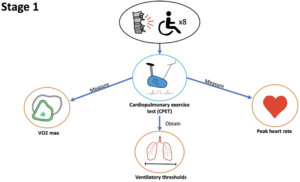Lay summary and infographic by Justin Yap
Edited by Crystal Han and Jocelyn Chan
This is a lay summary of the article by Amanda Barboza Tosi, Julio Cesar Silva de Sousa, Cláudia Lúcia de Moraes Forjaz, and Camila Torriani-Pasin. Read the original article here.
Exercise for people with spinal cord injury (SCI) helps reduce the risk of adverse cardiovascular function and obesity. However, there are several obstacles hindering physical activity participation, such as accessing exercise facilities, lack of resources, and engaging activities. Lack of physical activity may lead to adverse health outcomes. Active video games (AVG) are video games that involve body movement to participate. Past studies have found the use of AVG as a form of exercise helps overcome some of the barriers to exercise for people with SCI by demonstrating a positive effect on psychological (calmness and tension) and motivational components (reduced pain). While AVG shows potential in reducing barriers to exercise and improving health benefits, the required intensity of AVG to obtain these health benefits is unknown.
What is the purpose of the study?
This study aimed to determine the intensity of active video games by measuring the heart rate and oxygen consumption during exercise (VO2) of participants to quantify energy expenditure and obtain ventilatory thresholds. Ventilatory thresholds are markers that describe a range to help quantify the intensity of an aerobic stimulus (“cardio”). Exercise intensity that falls within this threshold is considered optimal to improve aerobic capacity.
How was the study conducted?
Eight people between the age of 18-50 years old with paraplegic injuries at the thoracic, lumbar or sacral levels were included in the study. The study procedure was broken down into two steps:
- Study participants performed a cardiopulmonary exercise test (CPET) to determine the following parameters: ventilatory threshold, peak heart rate, and VO2 max
- 48 hours after the CPET, participants completed the following three sessions in random order:
- One control session consisting of watching a movie
- Two AVG sessions each with four sets consisting of tennis AVG, and boxing AVG
HR and VO2 were constantly measured throughout each session and the average of these values was taken. Energy expenditure (EE) was calculated using the average VO2 for each session divided by the energy spent at rest (metabolic equivalents) for individuals with SCI. Ventilatory threshold was obtained by tracking breathing rate and VO2 max changes and compared betwen AVGs.


What were the main findings of the study?
Overall, AVGs were found to be a low intensity aerobic stimulus for people with SCI. Boxing was found to be a greater aerobic stimulus than tennis, meaning boxing showed a greater increase in heart rate and VO2. This suggests that the AVG boxing is a greater intensity activity than tennis AVG. One limitation is the small sample size of participants reduces this study’s ability to draw significant differences between the AVG and control groups. Additionally, findings may not be generalizable to all individual’s with SCI due to a small pool of injury levels tested.
Why is this important for the SCI community?
AVG can be used as a low intensity exercise or as a complement to conventional rehabilitation programs for people with SCI. Since AVG is accessible and can be done at home, this may increase the frequency and duration of AVG usage. Further, as obesity is quite common due to limited mobilty in individuals with SCI, energy used when playing these AVG also could aid in weight loss.

